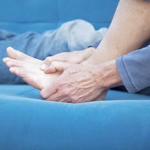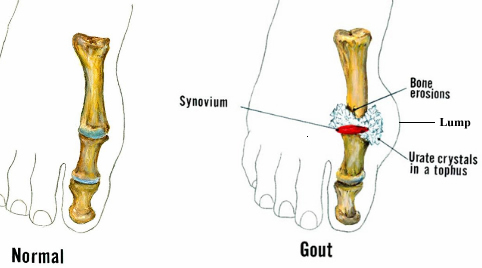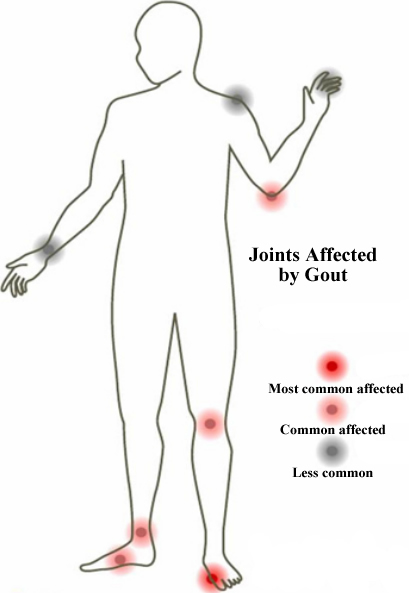How Does Gout Affect the Body?
Gout can cause uncomfortable symptoms (especially such as intense and sudden pain) in the affected joint. There are also some complications associated with this kind of arthritis. Some treatments are available, though there is a chance for it to become chronic. How does it affect the body?
 The excess accumulation of needle-like crystals (uric acid) in the joint is the main reason behind gouty arthritis. Uric acid itself is produced from purines. And there are some foods rich in purines – see more in this section!
The excess accumulation of needle-like crystals (uric acid) in the joint is the main reason behind gouty arthritis. Uric acid itself is produced from purines. And there are some foods rich in purines – see more in this section!
Excess purines from foods that we eat are normally removed from the body when they pass through kidneys, and then go away with urine when we pee. But due to certain conditions, the body fails to control the normal levels of uric acid in the blood.
The uric acid level increases when the body get more intakes of purines (you can get them from foods that you eat, as noted before) or/and when the kidneys doesn’t work optimal in removing the uric acid from bloodstream.
Many health problems that affect the performance of the kidneys may increase the risk of gout. These include: diabetes, hypertension (high blood pressure), hyperglycemia (high blood sugar), and other disorders/ diseases related to the function of the kidneys.
The excess uric acid can cause the depositions of urate crystals in certain parts of the body, most likely in the larger joints of big toe, increasing the risk of inflammation. In severe case, these crystal build-ups may cause lumps in the affected joints, see the picture below (picture credit to HSS).
Many times, people with gout don’t realize that they have it until the symptoms occur. Typically, the symptoms strike suddenly. At first it usually affects only one joint. But as the disease progresses, several joints can be affected.
Again, most commonly gout occurs in the big toe’s joint, the site of where usually the disease occurs in the first attack. Ankles and knees, and some small joints in the feet are other targets.
Sometime the disease also can be found in hand (especially elbow) and wrist. There is a chance for the disease to affect other joints of the body, too. Below is a picture of common sites affected by gouty arthritis (image credit to HSS).
Within hours, the affected joint during flare-up can be:
- Painful.
- Swollen.
- Having increased temperature, it can be relatively warmer than usual when you touch it.
- Redness.
- Or stiff.
In the first attack, the affected joint is relatively easier to be treated if compared to the next flares of gout at the advanced stage. As the disease becomes worse, the symptoms can last longer and become more painful, a stage of when the lifestyle approaches is usually not enough for coping.
Gout can coexist with other kinds of arthritis. For instance, it can be found in people with osteoarthritis, a most common arthritis. When it coexists with osteoarthritis, it is more likely to be found in the joints of the finger. See also osteoarthritis in the fingers!
The progression of gout may vary from one sufferer to another. But in general, it is classified into the following 4 major stages.
Stage I
It is the period of when sufferer has increased uric acid levels in the blood, but without gout or kidney disease. High uric acid is commonly not considered as gout until the symptoms of gout occur.
Stage II
This is the time of when the first attack of gout is noticed. It is also called as the first acute gout attack. Initially, gout usually causes sudden pain and tenderness in one joint, as noted before. Then within hours, the classic inflammation symptoms such as redness, heat, and swelling may also appear.
An interesting fact, the first attack could go away spontaneously even without treatment. Without treatment, the first flare gets its peak level about 1-2 days, and then will gradually subside a few days afterward.
Stage III
This is the interval phase between the first attack and other attacks before eventually going into the advanced stage of the disease. In other words, it is the phase of when you feel normal after the first attack but still you are greater risk of getting ‘recurrence attack’.
The time of when the second attack occurs can vary. A person with gout could have the second attack about a year, 2 years, 5 years, or longer after the first attack. In this phase, many suffers are more likely to less aware to the disease. They may think that their disease has completely gone and tend to not follow the treatment plan.
The good news, some sufferers never experience the second attack. And luckily, gout may be the most treatable arthritis, though the pain from gout can be extremely painful.





